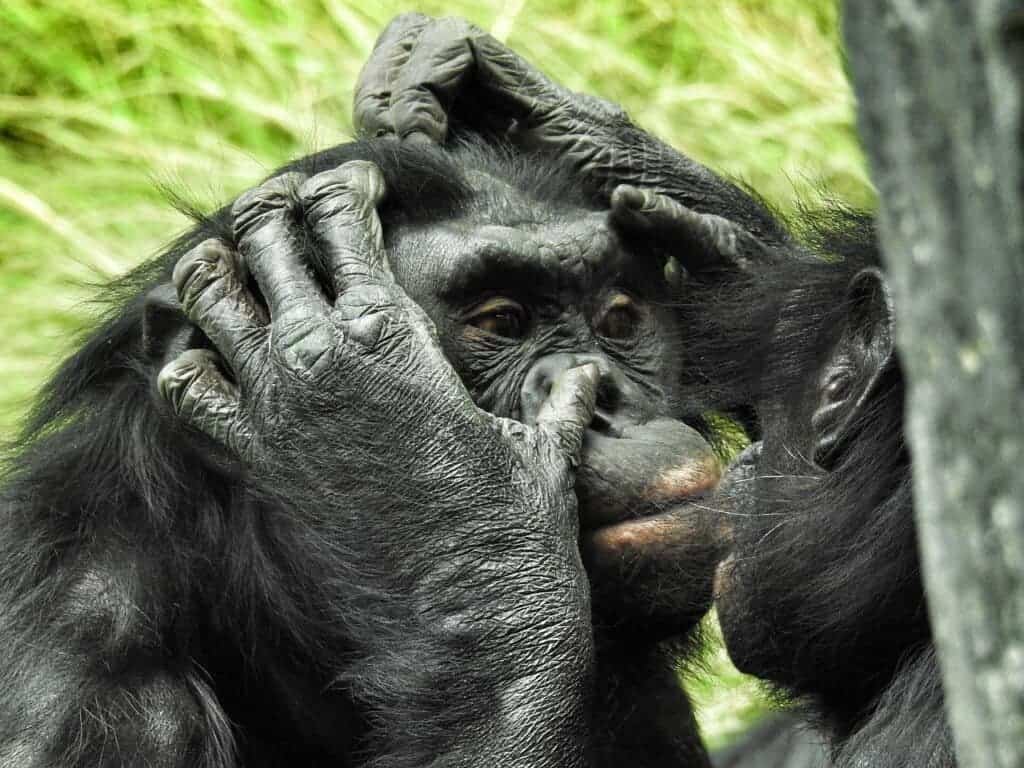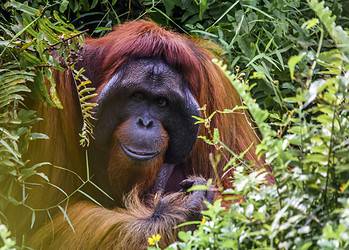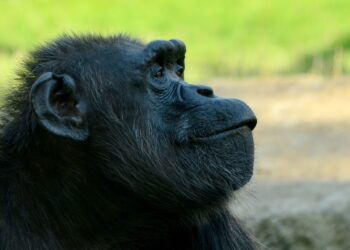
When it’s a simple “hi!”, a head nod, or a bow, humans across cultures signal acknowledgment of the person when engaging in conversation, acts of cooperation, or simply being in the presence of others. Likewise, we also signal disengagement with a gesture or vocalization signifying farewell. This complex social behavior has important implications beyond mere politeness, and apes seem to also purposefully signal the start and end of interactions, according to a new study.
“Investigating how humans and other primates use communication and gaze to coordinate joint action with others is fascinating! It is exciting because it happens on-the-fly – a spontaneous coordination process that bears witness of our sense of joint commitment. Watching two friends having lunch together tells much about how they value each other and their commitment to each other. We thought that, by looking at how apes get into and out of natural interaction of play and grooming, we might find a similar external structure of joint action as in humans; a way by which joint commitment could be studied naturally,” Raphaela Heesen, a postdoctoral researcher at Durham University in the United Kingdom, told ZME Science.
In order to act together to fulfill a common goal, whether it’s building a new house in their community or launching a rover on Mars, two or more people must be jointly committed to acting as a body. This mutual sense of obligation is known as joint commitment, and philosophers and scientists consider it integral to human cooperation, society at large, and the historical success of our species in shaping the world.
But is joint commitment unique to humans? Perhaps not. At least some aspects of it, such as signaling engagement and disengagement, may be shared by apes.
“In humans, joint commitment is not just a product (a mental state) but also a process, or “interactional achievement”. What it means is that, in order for us two to even establish a feeling of mutual obligation (a product of joint commitment) we have to go through an interactional process that requires mutual coordination (in the form of mutual gaze or exchange of communicative signals, in our case language). We first need to establish joint commitment in an entry phase, then maintain it, and later agree to dissolve it in an exit phase. Entry and exit phases of a joint action can thus be used as markers for joint commitment; therefore, entry and exit phases in non-human animal species can be analyzed to investigate joint commitment. In a species that doesn’t communicate before getting into an interaction and while getting out of it, this could mean that there is probably no commitment involved,” Heesen said.
Heesen and colleagues recorded interactions among chimpanzee and bonobo groups in order to investigate whether these closely related species also shared joint commitment features. They got the idea after considering anecdotal evidence that this may be the case. For instance, when two bonobos were interrupted during their grooming, they later used gestures to resume the interaction with each other. Was this a singular event? That’s what the researchers set out to investigate — and it turns out that both chimps and bonobos signal greetings and farewells.
“Our most important finding was that chimpanzees and bonobos do very frequently mutually gaze at each other and communicate when entering and exiting from joint actions.” Heesen said.
To arrive at these conclusions, the researchers analyzed more than 1,200 interactions within five different groups of bonobos and chimpanzees housed in zoos. Bonobos exchanged entry signals and mutual gaze prior to playing 90% of the time and chimps 69% of the time. Exit signals were even more common, with 92% of bonobo and 86% of chimpanzee interactions featuring them.
These greeting and farewell signals included gestures like touching each other, holding hands, butting heads, or gazing at each other.
Furthermore, when engaging in entry and exit phases, the apes took into consideration familiarity and power dynamics. Bonobos who were familiar with each other tended to have shorter entry and exit phases, if they existed at all. That’s pretty similar to how humans engage with close friends since they are not afraid to come off as rude or impolite. The shared social history allows them to more rapidly cut to the chase.
“The second most important finding was that, in bonobos, the phases seemed more affected by social dimensions, particularly social bond strength, compared to chimpanzees. Intriguingly, the pattern mirrored what we find in humans and what some people define as “social etiquette” or “politeness”: when interacting with a good friend, you are less likely to put effort into communicating politely. In bonobos, a similar pattern is evident in the structure of the joint action phases. Bonobos produce fewer and shorter entry and exit phases when initiating or terminating a joint action with a closely bonded conspecific as compared to when initiating or terminating a joint action with a weakly bonded one; this pattern was not apparent in chimpanzees by contrast,” Heesen explained, adding that this doesn’t necessarily mean that apes have notions of “politeness” or “social etiquette”, or at least not in the way humans perceive them. “It could also be explained by the fact that apes care about themselves and want to avoid risks with unfamiliar partners,” she added.
Interestingly, the degree of familiarity and strength of social bonds did not seem to have an impact on the social entries and exits among chimps. This may be owed to the strict hierarchical nature of chimp communities, whereas bonobos tend to be more egalitarian.
There are still many unknowns concerning the origin and evolution of joint commitment, but this study marks a step further in unraveling this behavior that’s so central to human society. Next, the researchers plan to investigate joint commitment in other great apes, such as orangutans and gorillas, as well as more distantly related species like wolves or dolphins.
“I think generally there is much to explore from the way in which primates communicate when coordinating joint action. And one way this can be done is by comparing how different species get into and out of social interactions with peers. There may well be differences in the complexity with which some species do so; perhaps other, more distantly related species do not even communicate when exiting from a social encounter; we advocate more studies to investigate this process,” Heesen concluded.
The findings appeared in the journal iScience.






